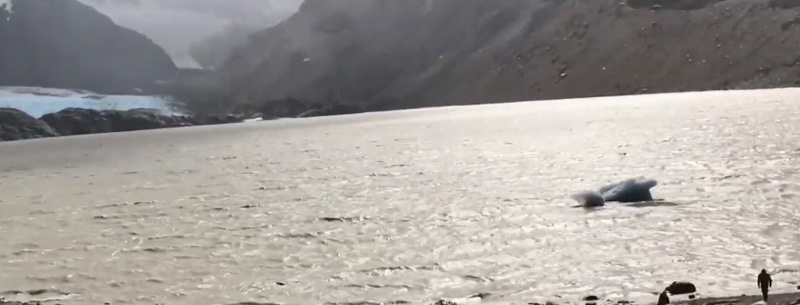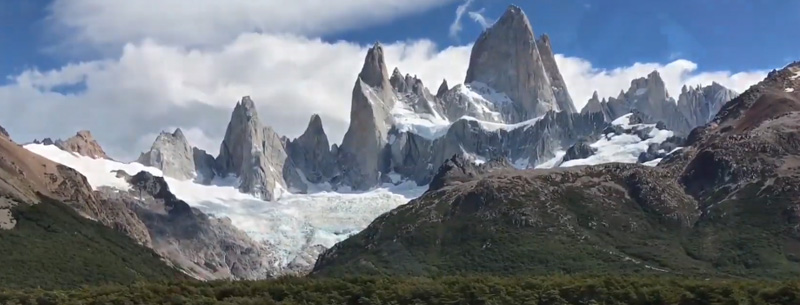Argentina is a heaven of the outdoor pursuit of all kinds. Adventurous travelers find here everything they want to do. In the southern part of the country, tourists can practice climbing in Lanín and Tronador mounts or climb walls of the Torre and Fitz Roy mounts, in a challenge even to the most experienced climbers. In Tierra del Fuego, visitors can enjoy a trip in dogsleds drawn by Siberian Huskies.

From the Tierra del Fuego coast, cruisers and sailing boats navigate through the Beagle channel to the Isla de Estados and Cabo de Hornos to Antarctica. In the northern and central region, visitors are invited to go hiking, take expeditions in off-road vehicles, go horseback riding, go bird watching, and climbing the central mountain range, including the Aconcagua (6,959 meters), In the Yungas region (forests covered with clouds), tourist can enjoy the landscape while is practicing hiking, biking, and horseback riding.
Around the Iguazú Falls, there are activities as hiking along the waterfall circuit, trekking into the jungle, and rafting along the river close to San Martin Island. Other outdoor pursuit possibilities are: hang gliding, paragliding, glider flying, hot air ballooning, kayaking, canoeing, windsurfing, and scuba-diving.
TREKKING AND HIKING
Argentina offers his magnificent settings and regional splendor, usually, a professional guide takes a group of hikers on the hiking trip and takes care of all the necessities. From the Andes Mountains; which provides an incomparable landscape ideal to go hiking; to Ushuaia, from the subtropical jungle to continental ice sheets, climbers and nature lovers have many options to enjoy nature.
Some of the hiking destinations that Argentina offers are:
- El Calafate is near to the most impressive glacier, the 15,000 rear old Perito Moreno;
- El Chalten where exists more than 350 glaciers and mountains covered in ice, the most famous are the Fitz Roy and Los Torres mountains;
- Tierra del Fuego, the undiscovered treasure of South America, you must get there while it is still unknown.
RAFTING
Rafting is a team sport, every crew member must have all the accessories (rows, helmets, life jackets, a dry jacket) to enjoy the adventure, the degree of difficulty is categorized according to the rivers, which varies from 1 (the easiest) to 6 degrees (for experts). In Argentina, exists many rivers with rushing waters, rough sediments, water-covered stones, and new rapids popping up here and there. A rafting expedition in Argentina will meet all your expectations.
CLIMBING
Climbing is one of the activities that increase its followers, this sport requires physical strength in both arms and legs and a skilled scaling technique because is considered a high-risk sport, is recommended not to climb alone and always use the correct equipment (waist harness, safety snap links, cat paw shoes and use magnesium resin that prevents the sweating of the hands).
Argentina has privileged geography to practice extreme climbing, rock or ice climbing, rappelling or Tyrolese rope crossing. Mounts such as the Aconcagua, the Fitz Roy, the Cerro Torre, and the Torres del Paine are popular. In Argentina, there are 9 out of 12 of the highest summits in the Americas, but beyond the most demanding walls, you can choose among the Tronador mount, the needles of the Catedral, the virgin summits of Tierra del Fuego, the provocative hills of Córdoba and Tandil, y and the uphill hiking in Catamarca, Salta and Jujuy.
FISHING
Argentina offers great opportunities for fly fishing, with a number of excellent fish to challenge and impress any angler, the dorado, salmon, trout among other, by example, a fisherman can fish a beautiful sea-brown trout in the great lakes and rivers of Tierra del Fuego or a wild rainbow and brown trout in the region of San Martin. The fishing season in Argentine for Trolling is from de middle of November to the middle of April; the Lake Fishing season starts from November to December, and for Fly Casting is from January to April.
The best-known trout fishing area is located near Junin / San Martin de Los Andres, here can be found the Malleo River, Chimehuin River, Collon Cura River, Alumine River, Calleufu River, Traful River, the Quemquemtreu River, and the Quillen River. An area more uncrowded than Junin / San Martin is The Esquel region, which also offers a wide variety of fishing opportunities. In Patagonia, the landlocked salmon and dorado are plentiful, also known as “the river Tigre”, the Dorado is the most exciting native fish in South America. In Buenos Aires, the Parana River Delta is the main destination for fishing, in Corrientes, the Ibera Marshes recently declared a Provincial Natural Reserve, is a beautiful place to fish, Around Mar del Plata, the best destinations are Resistencia, along the Parana River, on Cerrito Island or Paso de la Patria.
Regions of Argentina
Argentina, the second-largest country in South America, is a vast nation, with expansive deserts, impressive waterfalls, tropical rain-forests, beaches, mountains covered with snow, because of that Argentina is divided into geographical areas. each one offering much to the visitors.
PAMPAS REGION
Pampa is a Quechua word that means “plain”, is the bread-basket of Argentina, the Pampas region include the provinces of Buenos Aires, La Pampa, Santa Fe, and Córdova. This region is known as the Land of the Gaucho, all the romantic fantasies about this important figure are concentrated in this region. The Pampas is divided by climate into:
- The Humid Pampas, along the seaboard, cover most of the province of Buenos Aires and Cordova and a great part of the provinces of Santa Fe and La Pampa is the most fertile region in the country.
- Dry Pampas, in the west and south, cover part of La Pampa and the San Luis province, this region is drier and utilized mainly for pasturing, is famous for its sheep and horses.
MESOPOTAMIA REGION
The territory between the Parana and Uruguay rivers is called Mesopotamia (“between the rivers” in Greek), is a humid area in the north-east of Argentina, comprising the provinces of Corrientes, Misiones, Entre Rios, and part of the provinces of Formosa, Chaco, and Santa Fè. Mesopotamia is an area of heavy rainfall, particularly in August and September, up to 2,000 mm annually. In the northeast part of Mesopotamia, rivers go down over the borders of the great Paraná Plateau and produce spectacular waterfalls including the great natural wonder “Iguazú Falls”.
Misiones, in the northern part of Mesopotamia, is nearly enclosed by Brazil and Paraguay, is covered by subtropical forest, with species like alligators, toucans, and monkeys, the main attractions in this region are a section of the Iguazú Falls and the Jesuit Monasteries. Corrientes, is an extensive area of low hills, flatland apt for plant growing, and flooded forest at Iberá Wetlands and Entre Rios is embraced with productive pasture land stretching into Uruguay. Yerba mate is grown extensively in Mesopotamia; 1,800 square kilometers of Misiones are dedicated to its cultivation.
NORTHWEST REGION
This region is the highest in average elevation, is composed by Jujuy, Salta, Catamarca and Tucumán provinces. The provinces of this region present a variate range of climates: since cold and dry in the Puna and the western side of the Andean mountains to subtropical with abundant rain as in the Yungas jungle.
This region is divided into three sub-regions:
- The Puna. This extensive plateau exceeds the borders of Argentina and is formed by plateaus that vary between 3,000 and 3,500 meters above sea level, this plateaus are separated by the Mountain Ranges that characterize the place.
- The Eastern Mountain Range. It presents three distinct types of mountainous chains, we can differentiate between the Western and the Eastern Cordillera.
- The Sub Andean Mountain Ranges. Ranges of small and parallel mountains, positioned in a North Eastern – South-Western direction.
For tourism, the most frequent destination are Quebrada de Humahuaca, the Cerro de los Siete Colores, Cafayate, the Valle Calchaquíes, San Miguel de Tucumán, San Fernando del Valle de Catamarca, Salta and San Salvador de Jujuy. The culture of this region has strong influences of Quechua and Aymara cultures, the differences with European Buenos Aires can be seen in the music, clothing and custom of the people.
GRAN CHACO REGION
Chaco comes from the Quechua word “chaqu” (hunting land), Argentina shares this region with Bolivia, Paraguay, and Brazil. The Argentine part covers the Chaco and Formosa provinces. This region has some of the highest temperatures in South America, is sparsely populated, dotted with subtropical forests, scrub-land, and some wetlands. The fragile ecosystems of the Gran Chaco are being destroyed by a civilization with the burning of vegetation, the introduction of cattle, and carefree agricultural decisions. Being in danger the Chacoan Peccary (Catagonus wagneri) a mammal endemic to the Chaco.
In 1995, was established the Kaa Iya del Gran Chaco National Park, administered by the indigenous peoples which include the Izoceño Guaraní, the Ayoreode, and the Chiquitano. Also, the Chaco has the oldest city of Argentina, Santiago del Estero, founded in 1553, as a stopover between the mines of Bolivia and the coastline gateways in the Ocean.
CUYO REGION
Cuyo is located in the western bound of the country, is a mountainous area and wine-producing. In the main mountain range is the highest peak on the American Continent, the Aconcagua, with his altitude of 6959 meters above sea level and the Ischigualasto Provincial Park. This region comprises the provinces of Mendoza, San Juan, San Luis La Rioja, and the western portions of Salta. It is a political and economic macro-region.
Is a Region dominated by the imposing snow-covered Andes Mountains, the ground is arid and reddish, most rivers are fed by the thawing of snow of the peaks, the Rio Desaguadero (Drainage River) is the main collector, receiving waters from the Bermejo, Vinchina, and Salado River, before reaching the Colorado River. The east of this region constitutes one of the driest places of the country, but Mendoza and San Juan provinces are irrigated lowland oasis, with almost 80% of wine production in the country, its wines are highly considered in the world.
The colonial low houses and churches and narrow streets are the characteristics of the towns and cities in Cuyo, contrasting the modern constructions with the traditional ones.
PATAGONIA REGION
The name Patagonia comes from Patagon (a Spanish word that means Big-foot), The vast region features a glacier-dotted mountainous interior, unique coastal wildlife, forest growing in western fringes, large lakes, and amazing Andean national parks. The lakes and mountains are possibly one of the most beautiful in the world. In Patagonia, the provinces of Chubut, Neuquen, Rio Negro, and Santa Cruz has a temperate climate.
The main touristic destinations in Patagonia are Peninsula Valdes, Moreno Glacier, San Carlos de Bariloche, and Nahuel Huapi National Park. The glaciers and the area around San Carlos de Bariloche are year-round resort areas for skiers, trekkers, and nature lovers. Patagonia is a region with several oil and coal fields and exists colonies of sea animals in the gulfs and bays along the coastal cliffs.
ARGENTINEAN ANTARCTIC REGION
Is the Southernmost region of Argentina, it consists of the Antarctic Peninsula and a triangular section extending to the South Pole. Antarctica is the coldest, driest region on Earth, is covered in snow most of the year.
A journey to this region is an adventure by itself, the fauna is made up of seals, whales, penguins, migratory seabirds, and others. In an anecdote, in 1978, the first Antarctic baby was born in the Argentinean antarctic region under the name of Emilio Palma.
